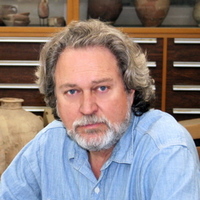
Madadh Richey
Assistant Professor of Hebrew Bible, Brandeis University
Ph.D. University of Chicago (NELC)
she/her; first name is "MAD-a"
Contact: richey@brandeis.edu
Ph.D. University of Chicago (NELC)
she/her; first name is "MAD-a"
Contact: richey@brandeis.edu
less
Related Authors
Koert van Bekkum
Evangelische Theologische Faculteit, Leuven
Benjamin Suchard
KU Leuven
Matthieu Richelle
UCLouvain (University of Louvain)
Ron Hendel
University of California, Berkeley
Idan Dershowitz
Monash University
James D . Tabor
The Hebrew University of Jerusalem
Benjamin Sass
Tel Aviv University
InterestsView All (26)










Uploads
Papers by Madadh Richey
* Full text of this article may not yet be posted, by publisher agreement. Feel free to contact me by email if you would like to access this article. Information on the journal issue is available here: https://www.tandfonline.com/toc/ytav20/49/1?nav=tocList
* Full text of this article may not yet be posted, by publisher agreement. Feel free to contact me by email if you would like to access this article. Information on the journal volume is available here: http://www.brepols.net/Pages/ShowProduct.aspx?prod_id=IS-9782503592411-1
* For the volume, see: https://rowman.com/ISBN/9781793640253/Religion-Culture-and-the-Monstrous-Of-Gods-and-Monsters
* Full text of this chapter may not be posted, by publisher agreement. Feel free to contact me by email if you would like to access this chapter. For the volume, see: https://www.bloomsbury.com/us/scribes-and-scribalism-9780567659743/
* See also an earlier publication that came to my attention in May 2021, courtesy of Andrew Burlingame: Charles Clermont-Ganneau, Les fraudes archéologiques en Palestine (Bibliothèque Orientale Elzévirienne 40; Paris: Leroux, 1885), 343-46.
** Full text of this article may not be posted, by publisher agreement. For the volume, see: https://global.oup.com/academic/product/the-oxford-handbook-of-the-phoenician-and-punic-mediterranean-9780190499341?cc=us&lang=en&#
* Full text of this article may not be posted, by publisher agreement. For the volume, see: https://global.oup.com/academic/product/the-oxford-handbook-of-the-phoenician-and-punic-mediterranean-9780190499341?cc=us&lang=en&#
Une statuette en bronze de Pazuzu (AN 1892.43), offerte au musée Ashmolean par Greville John Chester en 1892 et prétendument de Tanis, porte sur ses jambes une inscription araméenne de quatre lignes qui n’a jamais été lue de façon satisfaisante. Sur la base d’une autopsie et de la photographie RTI (reflectance transformation imaging, imagerie par transformation de la réflectance) entreprise à l’Ashmolean en octobre 2016, les auteurs présentent un déchiffrement et une discussion à la fois paléographique, linguistique et contextuelle de cette inscription exceptionnelle en araméen ancien, datant d’environ 725-700 avant notre ère. L’inscription donne de brèves instructions pour le placement d’une figurine protectrice appelée « Sassām » près des oreillers et du lit d’un individu qui n’est pas nommé et enjoint à cette figurine de protéger ces lieux et peut-être aussi d’en chasser le mal. Cette figurine et son inscription attestent plusieurs similitudes avec les textes magiques mésopotamiens et les arts visuels décrivant la protection d’un lit de malade contre les forces nuisibles. Cela montre que les scribes araméens du début du premier millénaire ont adapté de manière créative le discours magique du Proche-Orient ancien.
recovered in 2011 from the so-called ‘Babylonian-Persian pit’ at Ramat Raḥel.The seal was incised in the positive and the impression reads, in reverse, yhwd /gdlyh, ‘Yĕhûd Gĕdalyāh’, showing that it clearly belongs in the Yehud stamp impression corpus. It displays similarities to type 11 stamp impressions, which were also incised in the positive, and reads, in two lines, gdlyh. Without making a definitive identification of the individual named in the two different seal types, we recognize several similarities with the type 11 stamp impressions (now labeled ‘type 11a’) and label the new seal ‘type 11b’. Palaeographical, archaeological and typological characteristics suggest that the new stamp impression type is among the last of the so-called early types and should probably be dated to the latter half of the fifth century BCE.
* Full text of this article may not yet be posted, by publisher agreement. Feel free to contact me by email if you would like to access this article. Information on the journal issue is available here: https://www.tandfonline.com/toc/ytav20/49/1?nav=tocList
* Full text of this article may not yet be posted, by publisher agreement. Feel free to contact me by email if you would like to access this article. Information on the journal volume is available here: http://www.brepols.net/Pages/ShowProduct.aspx?prod_id=IS-9782503592411-1
* For the volume, see: https://rowman.com/ISBN/9781793640253/Religion-Culture-and-the-Monstrous-Of-Gods-and-Monsters
* Full text of this chapter may not be posted, by publisher agreement. Feel free to contact me by email if you would like to access this chapter. For the volume, see: https://www.bloomsbury.com/us/scribes-and-scribalism-9780567659743/
* See also an earlier publication that came to my attention in May 2021, courtesy of Andrew Burlingame: Charles Clermont-Ganneau, Les fraudes archéologiques en Palestine (Bibliothèque Orientale Elzévirienne 40; Paris: Leroux, 1885), 343-46.
** Full text of this article may not be posted, by publisher agreement. For the volume, see: https://global.oup.com/academic/product/the-oxford-handbook-of-the-phoenician-and-punic-mediterranean-9780190499341?cc=us&lang=en&#
* Full text of this article may not be posted, by publisher agreement. For the volume, see: https://global.oup.com/academic/product/the-oxford-handbook-of-the-phoenician-and-punic-mediterranean-9780190499341?cc=us&lang=en&#
Une statuette en bronze de Pazuzu (AN 1892.43), offerte au musée Ashmolean par Greville John Chester en 1892 et prétendument de Tanis, porte sur ses jambes une inscription araméenne de quatre lignes qui n’a jamais été lue de façon satisfaisante. Sur la base d’une autopsie et de la photographie RTI (reflectance transformation imaging, imagerie par transformation de la réflectance) entreprise à l’Ashmolean en octobre 2016, les auteurs présentent un déchiffrement et une discussion à la fois paléographique, linguistique et contextuelle de cette inscription exceptionnelle en araméen ancien, datant d’environ 725-700 avant notre ère. L’inscription donne de brèves instructions pour le placement d’une figurine protectrice appelée « Sassām » près des oreillers et du lit d’un individu qui n’est pas nommé et enjoint à cette figurine de protéger ces lieux et peut-être aussi d’en chasser le mal. Cette figurine et son inscription attestent plusieurs similitudes avec les textes magiques mésopotamiens et les arts visuels décrivant la protection d’un lit de malade contre les forces nuisibles. Cela montre que les scribes araméens du début du premier millénaire ont adapté de manière créative le discours magique du Proche-Orient ancien.
recovered in 2011 from the so-called ‘Babylonian-Persian pit’ at Ramat Raḥel.The seal was incised in the positive and the impression reads, in reverse, yhwd /gdlyh, ‘Yĕhûd Gĕdalyāh’, showing that it clearly belongs in the Yehud stamp impression corpus. It displays similarities to type 11 stamp impressions, which were also incised in the positive, and reads, in two lines, gdlyh. Without making a definitive identification of the individual named in the two different seal types, we recognize several similarities with the type 11 stamp impressions (now labeled ‘type 11a’) and label the new seal ‘type 11b’. Palaeographical, archaeological and typological characteristics suggest that the new stamp impression type is among the last of the so-called early types and should probably be dated to the latter half of the fifth century BCE.